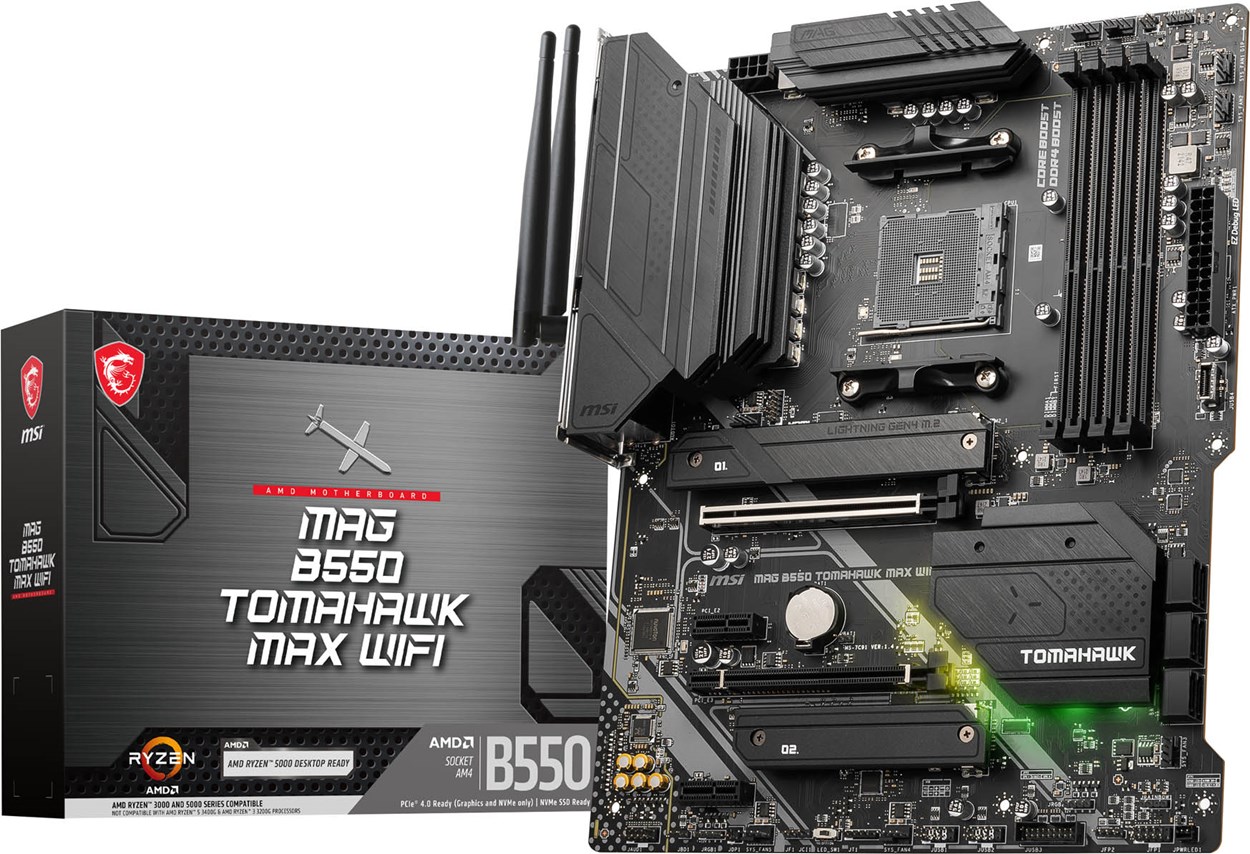AMD's 3D V-Cache Enhanced Zen 3 Ryzen CPUs Will Be AM4 Compatible
Not only are the new Zen 3 Ryzen chips designed to offer a performance jump of 15% in gaming builds, the chiplet technology has actually been designed for AM4 motherboards. The new CPUs we’re getting in early 2022 will see the introduction of AMD’s V-Cache technology, but they have not been designed to roll out with the new socket, excluding AMD’s staunch supporters who already own expensive AM4 motherboards. In a sensible move, they designed Zen 3 with AM4 in mind.
AMD unveiled their 3D V-Cache technology at Computex 2021 and displayed their innovative stacking of a 64MB SRAM chip onto an existing Zen 3 silicon, tripling the size of its L3 cache, thereby increasing the capacity and bandwidth potential of Zen 3 L3 cache. On AMD's 12-core Ryzen 9 test CPU, AMD demonstrated the use of 2x Zen 3 chiplets, creating an “enhanced” Ryzen 9 5900X with 192MB of L3 Cache.
AMD 3D V-Cache technology, then, introduces us to a brand-new world of performance for gamers, offering direct SRAM accessibility with no significant increase in latency, according to AMD. The company’s partnership with TSMC means the silicon processing is well taken care of, and AMD get to focus 100% on the engineering – their main strength in CPU manufacturing.
AMD FidelityFX Super Resolution – or FSR - is something you will have heard about if you are interested in the Zen 3 chips coming our way and are a prime example of AMD’s marketing prowess.
Godfall FidelityFX demonstration by AMD screenshot
AMD's also benchmarks showed a 25% improvement in Monster Hunter World using DX11, using a prototype 12-Core 3D chiplet on a Ryzen 9 5900X chip, which is a significant leap for a game that is often used in benchmarks and FPS comparisons.
3D V-Cache performance uplift
AMD headlined that FSR will be available on all Radeon RX 6000, RX 5000, RX 500 and RX Vega – as well as all Ryzen processors with Radeon graphics. The major news was, of course, the compatibility with competitor graphics cards.
During this keynote from AMD, the audience was delighted to see they chose a GTX 1060 as the GPU that would show off the FidelityFX Super Resolution, which also happens to be the most used GPU by gamers on Steam. This is such an incredible move from AMD, showing that they don’t expect everyone to just upgrade an entire specification just to take advantage of a new CPU. Compatibility across older and newer gamer builds is very important to them – even with competitor products - and this will positively affect their market penetration in the first quarters of 2022.
Credit: Steam Video Graphics Survey Sept 2021
This is great news for everyone, it seems, and anyone rocking an AM4 motherboard and Nvidia/Radeon graphics can potentially benefit from FSR next year, even if they are using integrated graphics in an APU processor.
All of this means that buying an AM4 motherboard right now will not impede your performance gains next year if you are shopping around for a new CPU in 2022 onwards. AMD is committed to keeping their fans happy, and this is most apparent with the 3D V-Cache and FSR announcements.
AM4 Motherboards Compared
Release Dates
X570 – Released: July 2019
B550 – Released: June 2020
A520 – Released: August 2020
Specifications
* PBO: Precision Boost Overdrive is a feature to extend CPU parameters for performance on a Ryzen CPU such as SoC power, Temperature, and VRM Current. PBO is AMD’s inbuilt overclocking features baked into your CPU.
AMD AM4 X570 Motherboards
The one feature you will see banded around by review websites and technical writers is the onboard fan which all of the best X570 motherboards have for cooling the chipset. The X570S chipset motherboards do not have a fan, a decision made by manufacturers to reduce any fan noise on early boards – a problem most system builders assumed they would have. In actual fact, with BIOS tweaks alone, the fan noise was not noticeable on X570 motherboards, so the “S” version was a bit of a lame duck. With other fans in the case whirring away, these small motherboard fans were pretty quiet.
The X570 motherboard is comparable to Intel's Z590 motherboards, and the price jump appears to be the same in the Intel corner, too. With those extra specs come a price difference, but a standard X570 motherboard comes in at under £150 at the low end, and up to £700 for a ROG masterpiece.
At the low end, the X570 Socket AM4 AMD motherboards support AMD Ryzen 5000 Series/ Ryzen 5000 G-Series/ Ryzen 4000 G-Series/ 3rd Gen Ryzen/ 2nd Gen Ryzen/ 2nd Gen Ryzen with Radeon Vega Graphics/ Ryzen with Radeon Vega Graphics Processors. You won’t have as many options in terms of USB connectivity, audio jacks, fan headers, M.2 slots or supported memory bus speeds that the higher priced boards may have, but it will certainly do the job at the low budget end.
Both the X570 and Z590 AMD boards can run PCIe 4.0 16x for the GPU, and PCIe 4.0 4x NVMe, which is really all a system builder is initially looking at in terms of high-performance gaming, and you’ll get up to 128GB RAM supported, too, across 99% of X570 chipset boards.
When it comes to processors, you can install any AM4 CPU from the Zen+, Zen 2 and Zen 3 CPU architecture, meaning AMD Ryzen 2000, Ryzen 3000 and Ryzen 5000 CPUs on X570 motherboards.
AMD AM4 B550 Motherboards
The best B550 motherboards will always be compared to the X570, and this is probably an unfair fight. The B550 was designed to ensure X16 PCIe Gen 4 GPU uplink over the B450’s X16 PCIe Gen 3. The B550 also benefits from PCIe Gen 4 support for SSD storage, which sets users up for Windows 11’s DirectStorage capabilities (when developers begin to adopt it) and forms the foundations of high-end gaming builds.
| | B450 | B550 | X570 |
| CPU Graphics Support | X16 PCIe 3.0 | X16 PCIe 4.0 | X16 PCIe 4.0 |
| Dual Graphics Support | No | Yes | Yes |
| CPU Storage Support | PCIe 3.0 | PCIe 4.0 | PCIe 4.0 |
| General Purpose Lanes | PCIe 2.0 | PCIe 3.0 | PCIe 4.0 |
| CPU Chipset Uplink | PCIe 3.0 | PCIe 3.0 | PCIe 4.0 |
| CPU USB Ports | USB 3.1 Gen 1 | USB 3.1 Gen 2 | USB 3.1 Gen 2 |
We haven’t covered the B450 in these comparisons, as the lack of PCIe Gen 4.0 support is not really worth the cost saving in terms of “futureproofing” your build for the next few years of hardware launches and game releases.
The B550 is the perfect balance of budget and performance for gaming builds, but if you are trying to save a few pounds by purchasing an older processor, you’ll need to check compatibility. The B550 chipset supports current and future Zen 3 processors, but at launch the motherboards did not support Ryzen 2000 or earlier processors, or the Ryzen 3000 APUs such as the great value AMD Ryzen 5 3400G & Ryzen 3 3200G. What this means is, if you already bought an older Ryzen 2000 CPU or Ryzen 3000 APU, you will need to check with AMD on the product page to ensure it is compatible with your B550 out of the box. Some B550 motherboards outright say they are not compatible in the specifications, too.
Unfortunately for the B550, ROM size limitations mean motherboard manufacturers are unable to support all current, future, and past Ryzen processors within one firmware package. You may need to update your B550 BIOS with a different CPU *before* you install your new processor. This encumbrance is not ideal for those who want an easy install when building a PC themselves.
Choosing a good value B550 motherboard is straightforward enough, and it will be a case of matching your performance & connectivity needs with the prices of each board.
At the very top end of the scale there are AMD motherboards like ASRock Taichi and Steel Legend series, as well as ASUS ROG Strix variations, which are currently around the £220 - £250 range. The specifications on these higher priced boards are outstanding, but may be superfluous for general use and gaming, so it is worth checking. The ASRock Taichi and ASUS ROG Strix both have fairly similar specs, but even with a price difference that means you can afford a Just Eat Cheeky Tuesday to boot, there are clear and significant differences depending on your needs.
As you can see from the below table, two of the B550 motherboards have several differences (we have left out all the specs that match on both boards).
| Description | ASRock B550 Taichi AMD Socket AM4 Motherboard | ASUS ROG Strix B550-XE Gaming WiFi AMD Motherboard |
| USB Ports | 1 x USB 3.1 Type-C | 1 x USB 3.1 Type-C |
| | 1 x USB 3.1 Type-A | 2 x USB 3.1 Type-A |
| | 4 x USB 3.0 | 1 x USB 2.0 Type-C |
| | 2 x USB 2.0 | 5 x USB 2.0 Type-A |
| DisplayPorts | 1 x DisplayPort 1.4 | 1 x DisplayPort 1.2 |
| Antenna Connectors | 2 x SMA Antennas | |
| S/PDIF Port | 1 x S/PDIF Optical Out | |
| SATA Connectors | 8 x SATA III | 6 x SATA III |
| Internal USB Connectors | 1 x USB 3.1 Type-C header | 1 x USB 3.1 header (supports 1 Type-C port) |
| | 2 x USB 3.0 headers (supports 4 ports) | 1 x USB 3.0 header (supports 2 ports) |
| | 2 x USB 2.0 headers (supports 4 ports) | 2 x USB 2.0 headers (supports 4 ports) |
| Speaker | 1 x Speaker header | |
| Cooling Fan Support | 1 x CPU fan header | 1 x CPU fan header |
| | 1 x CPU/Water Pump fan header | 1 x CPU_OPT fan header |
| | 5 x Chassis/Water Pump fan headers | 1 x AIO_PUMP header |
| | | 3 x Chassis fan headers |
| Thunderbolt Port(s) | | 1 x Thunderbolt header |
| Power Connector Port | 1 x 20+4-pin ATX | 1 x 20+4-pin ATX |
| | 2 x 4+4-pin EPS | 1 x 4+4-pin EPS |
| | | 1 x 4-pin EPS |
| Other Connectors | 1 x M.2, Socket 3, M Key (Type 2242/2260/2280/22110) | 2 x M.2, Socket 3, M Key (Type 2242/2260/2280/22110) |
| | 1 x M.2, Socket 3, M Key (Type 2242/2260/2280) | 2 x 3-pin ARGB headers |
| | 2 x RGB LED headers | 2 x 4-pin RGB headers |
| | 2 x Addressable LED headers | 1 x Thermal Sensor header |
| Memory Bus Speed | 5200+(OC) / 5100(OC) / 5000(OC) / 4933(OC) / 4866(OC) / 4800(OC) / 4733(OC) / 4666(OC) / 4600(OC) / 4533(OC) / 4466(OC) / 4400(OC) / 4333(OC) / 4266(OC) / 4200(OC) / 4133(OC) / 4000(OC) / 3866(OC) / 3800(OC) / 3733(OC) / 3600(OC) / 3466(OC) / 3200 / 2933 / 2667 / 2400 / 2133 MHz | 5100(O.C) / 4800(O.C.) / 4600(O.C) / 4400(O.C) / 4266(O.C.) / 4133(O.C.) / 4000(O.C.) / 3866(O.C.) / 3600(O.C.) / 3466(O.C.) / 3200 / 3000 / 2800 / 2666 / 2400 / 2133 MHz |
| SLi/Crossfire Features | Supports AMD Quad CrossFireX, 3-Way CrossFireX and CrossFireX | Supports NVIDIA 2-Way SLI Technology |
| | | Supports AMD 3-Way CrossFireX Technology |
| Memory Speed | 5200 MHz | 5100 MHz |
| Number of SATA Ports | 8 ports | 6 ports |
| Motherboard Power Connectors | 8 + 8-Pin | 4 + 8-Pin |
Most notably, we can see that the cheaper of the two, the ASUS ROG board, offers 1x Thunderbolt header, which is going to be a huge bonus to those using a PC for graphic design, video editing or if they need to transfer huge files on to a USB device to move the data. Memory bus speed is also a factor, with the ASRock B550 having much more options available – though this might not be such a deal-breaker if you already know which RAM you’re going to be buying before you buy a motherboard.
The differences above will be specific to your needs, and while I don’t need 4x USB 3.0 ports, I know plenty of people who do in the office. It’s horses for courses again, folks.
Down at the lower end of the market, we can see the B550 represents great value with MSI motherboards under £200. MSI's commitment to entry level and mid-range gaming is still unwavering, it seems. Even with boards that are now a couple of years old, there are a raft of features to be enjoyed.

You are not sacrificing too many features at this end of the scale, but it is worth checking the main specifications for a decent gaming PC, which would be: -
- Support for 64GB DDR4 RAM
- Minimum 1 x PCI Express 4.0 x16
- Minimum 1 x PCI Express 3.0 x1
- Supports Integrated Graphics (APU)
- HDMI & DVI
AMD AM4 A520 Motherboards
Although not many manufacturers have decided to make too many different models of A520, the ones that are available have the benefit of similarity in specification. This narrows down our buying options and makes things a little easier. AMD launched the A520 in 2020 and the headline is that this chipset supports the current generation of Ryzen 5000 processors, based on the Zen 3 architecture. The A520 chipset also supports the Ryzen 3000 processors (Zen 2 architecture).
An entry-level chipset, the A520 is purely for budget conscious PC builders who are looking at savings in other areas, perhaps to put toward RAM and GPU in a build. Most importantly, however, is the fact that the A520 is mostly available in mATX and ITX form factor, for the smaller case build.
As a small form factor motherboard, the A520 is slimmed down on the features, but SFF builders are well-used to this trade off. Affordability and build size are the factors here.
With few models available from the various manufacturers, our choices are limited, but in a good way. When the playing field is so small, it is easy to see which products stand out more than others.
The remaining A520 AMD motherboards that would be recommended by our builds team, are the lower budget ASRock A520M series, which is beginning to show its age a little - but still offers great value to the PC builder with an eye on their bank balance.
A520 vs B550 vs X570 – Which One Is Best?
Overall, you are not going to be spending much extra for the kind of features you will need moving forward in gaming, but PCIe 4.0 will be the kicker. With this in mind, a B550 motherboard with careful consideration for which processor you’ll be using represents the best value and performance balance.
Depending on your budget, an X570 motherboard will give you much more in terms of fast SSD and GPU performance, so, starting at a price most can afford, the cost for a X570 PC build is not out of the range of most PC enthusiasts.







